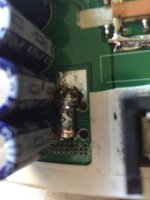Ah, the way you stated the wattmeter info implied you already had it and had made measurements during the ride.
About the cable and programming thing: There's zero reason for you to do that, to make a pack that came with the scooter compatible with the scooter. In this case, it's not OSN's fault that the pack isn't sufficient--it's the company that sold the scooter, for not providing a pack that would run it well. Or if the pack came with the scooter from a separate manufacturer, then it's that manufacturer's fault (but it is still the problem of the people that sold it, as far as the customer (you) is concerned).
The most important info that you need to know about this pack isn't on the page (other than that it comes with a BMS capable of 30A discharge). The specs listed on the linked battery imply the cells have infinite discharge current ability, which isn't true. Since they dont' list what the actual cell capabilities are, it's safe to assume they're actually 1C cells, maybe 2C at best (if you don't mind a lot of sag). Especially since they only call them "powerful", which usually means a vendor either has no idea what cells they are or what they're capable of, or that they know how low-end they are and don't want to put that in writing anywhere.
However, OSN almost certainly knows exactly what the cells are and can do, so its' likely they simply don't want to admit how low-capability (or average, for this type of cell) they actually are. Instead they hype them up in a way that makes people assume they're better than they are, without actually lying to anyone about it.
Side note: the info about charging cut off voltage is incomplete; it doesnt' actually list the per-cell HVC.
About the cable and programming thing: There's zero reason for you to do that, to make a pack that came with the scooter compatible with the scooter. In this case, it's not OSN's fault that the pack isn't sufficient--it's the company that sold the scooter, for not providing a pack that would run it well. Or if the pack came with the scooter from a separate manufacturer, then it's that manufacturer's fault (but it is still the problem of the people that sold it, as far as the customer (you) is concerned).
The most important info that you need to know about this pack isn't on the page (other than that it comes with a BMS capable of 30A discharge). The specs listed on the linked battery imply the cells have infinite discharge current ability, which isn't true. Since they dont' list what the actual cell capabilities are, it's safe to assume they're actually 1C cells, maybe 2C at best (if you don't mind a lot of sag). Especially since they only call them "powerful", which usually means a vendor either has no idea what cells they are or what they're capable of, or that they know how low-end they are and don't want to put that in writing anywhere.
However, OSN almost certainly knows exactly what the cells are and can do, so its' likely they simply don't want to admit how low-capability (or average, for this type of cell) they actually are. Instead they hype them up in a way that makes people assume they're better than they are, without actually lying to anyone about it.
Side note: the info about charging cut off voltage is incomplete; it doesnt' actually list the per-cell HVC.
Specifications
Model Number OSN-OS266-4812
Battery Chemicals LiFePo4 (Lithium Iron Phosphate)
Nominal Voltage 51.2V
Nominal Capacity 12Ah
Cell Inside LiFePO4 26650 CELL
Configuration 16S3P
BMS inside BMS-L16S3010-486
Standard Charging Current 2.4A
Continuous Discharging According to customers' requirement
Fully charged Voltage 58.4V(3.65V any single cell)
Charging Cut-off Voltage 62.4(any single cell)
Discharging Cut-off voltage 32V(2.0V any single cell)
Dimensions (L*W*H) 143x102x251mm
Weight 6.12kg
Working Temperature (Charging) 0°C ~45°C
Working Temperature (Discharging) -20°C ~55°C
Cycle Life 2000 times









